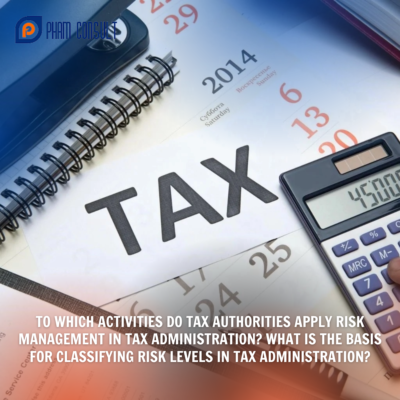Tax authorities apply risk management in tax administration to which activities? What is the classification of risk levels in tax administration based on? Is applying risk management in tax administration a principle of tax audit and tax inspection? Through today’s article, let’s learn about this issue with Pham Consult!

Tax authorities apply risk management in tax administration to which activities?
To know which activities the tax authority applies risk management in tax management, it is based on the provisions of Article 9 of the Law on Tax Administration 2019 as follows:
Risk management in tax management
1. Tax authorities apply risk management in tax registration, tax declaration, tax payment, tax debt, enforcement of administrative decisions on tax management, tax refund, tax audit, tax inspection, management and use of invoices, documents and other operations in tax management.
2. Customs authorities apply risk management in tax declaration, tax refund, tax non-collection, tax audit, tax inspection and other operations in tax management.
3. Applying the risk management mechanism in tax management includes the operations of collecting and processing information and data related to taxpayers; developing tax management criteria; assessing taxpayers’ compliance with the law; classify the level of risk in tax management and organize the implementation of appropriate tax management measures.
…
Thus, according to regulations, tax authorities apply risk management in the following activities:
– Tax registration, tax declaration, tax payment, tax debt;
– Enforce the implementation of administrative decisions on tax management;
– Tax refund, tax audit, tax inspection, management and use of invoices, documents and other operations in tax management.
Accordingly, applying the risk management mechanism in tax management includes the operations of collecting and processing information and data related to taxpayers; developing tax management criteria; assessing taxpayers’ compliance with the law; classifying the level of risk in tax management and organizing the implementation of appropriate tax management measures.
What is the basis for classifying the level of risk in tax management?
Pursuant to the provisions of Clause 4, Article 9 of the Law on Tax Administration 2019 as follows:
Risk management in tax administration
…
4. Assessment of taxpayers’ compliance with the law and classification of risk levels in tax administration are prescribed as follows:
a) Assessment of taxpayers’ compliance with the law is based on a system of criteria and information on the taxpayer’s history of operations, compliance with the law and cooperative relationship with tax authorities in implementing tax laws and the level of tax law violations;
b) Classification of risk levels in tax administration is based on taxpayers’ compliance with the law. In the process of classifying risk levels, tax authorities consider relevant contents, including information on risk signs; signs and violations in tax administration; information on the results of professional activities of tax authorities and other relevant agencies as prescribed in this Law;
c) Tax authorities use the results of the assessment of taxpayers’ compliance with the law and the results of the classification of risk levels in tax administration to apply appropriate tax administration measures.
5. Tax authorities apply information technology systems to automatically integrate and process data to serve the application of risk management in tax administration.
6. The Minister of Finance prescribes criteria for assessing taxpayers’ compliance with the law, classifying risk levels and applying risk management in tax administration.
Thus, according to regulations, tax authorities classify risk levels in tax administration based on taxpayers’ compliance with the law.
Accordingly, in the process of classifying risk levels, tax authorities consider relevant contents, including information on risk signs; signs and violations in tax administration; information on the results of professional activities of tax administration agencies and other relevant agencies as prescribed in the Law on Tax Administration 2019.
Is applying risk management in tax administration a principle of tax inspection and audit?
The principles of tax inspection and audit are stipulated in Article 107 of the Law on Tax Administration 2019, specifically as follows:
(1) Applying risk management in tax administration and applying information technology in tax inspection and audit.
(2) Complying with the provisions of this Law, other relevant legal provisions and tax inspection and audit forms, procedures, processes and records as prescribed by the Minister of Finance.
(3) Not obstructing the normal operations of taxpayers.
(4) When conducting tax inspections and audits at the taxpayer’s headquarters, the head of the tax administration agency must issue a decision on inspection and audit.(5) Tax audits and tax inspections aim to assess the completeness, accuracy and honesty of the contents of documents, information and records that taxpayers have declared, submitted and presented to tax authorities; assess taxpayers’ compliance with tax laws and other relevant legal provisions to handle taxes in accordance with the law.
Thus, applying risk management in tax management is a principle of tax audits and tax inspections as prescribed.
Pham Consult hopes that the above information will be helpful to your work.
Comments




 VI
VI